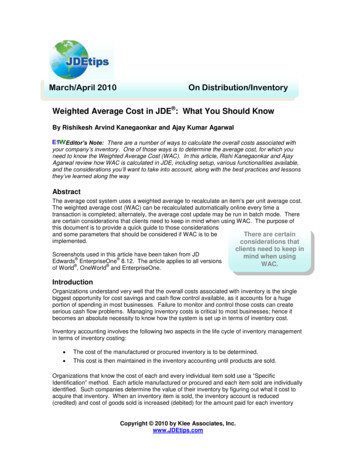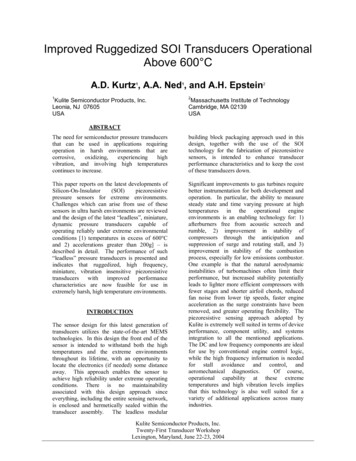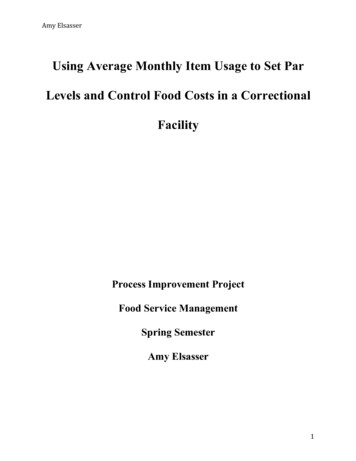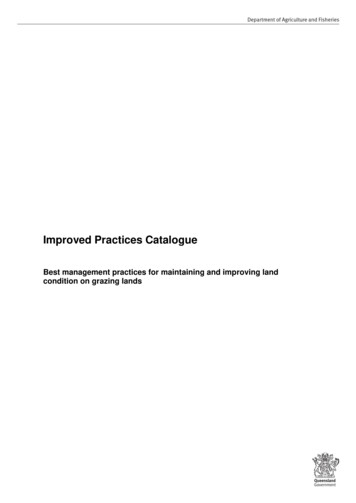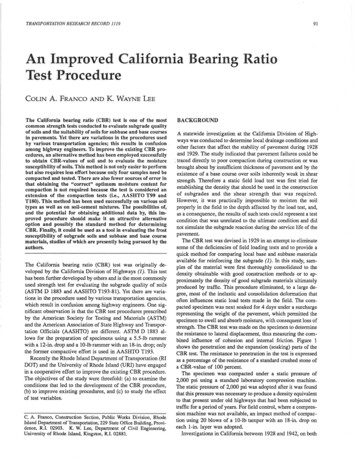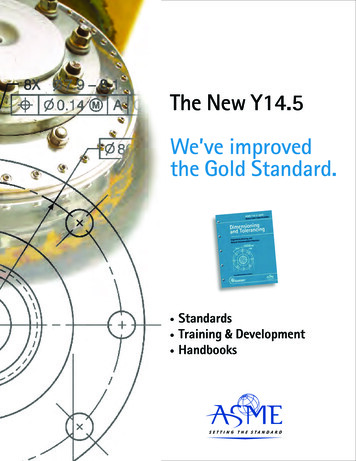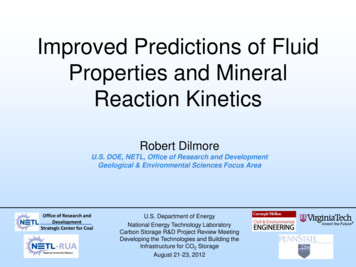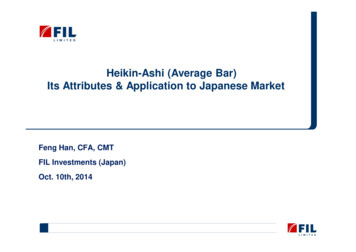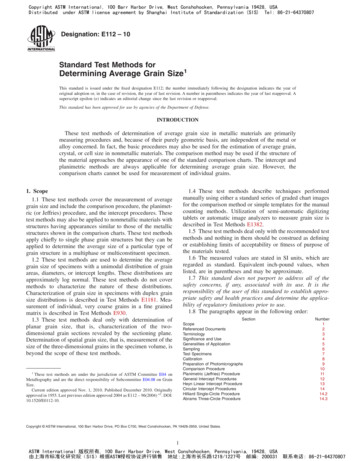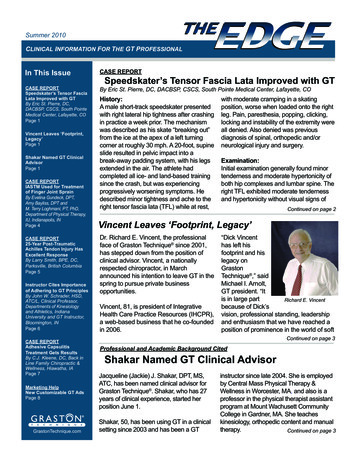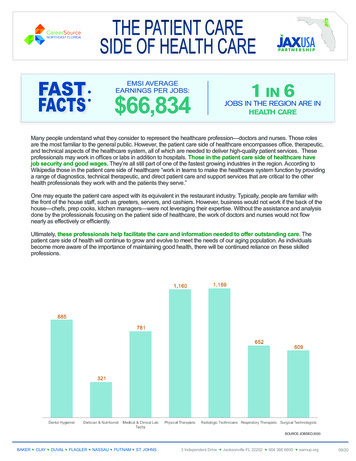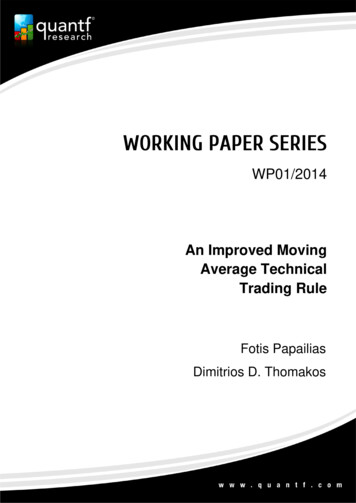
Transcription
WORKING PAPER SERIESWP01/2014An Improved MovingAverage TechnicalTrading RuleFotis PapailiasDimitrios D. ThomakosElectronic copy available at: http://ssrn.com/abstract 1926376
quantf research Working Paper Series: WP01/2014An Improved Moving Average Technical Trading RuleFotis Papailias1,q *, Dimitrios D. Thomakos2,3,qAbstractThis paper proposes a modified version of the widely used price and moving average cross-over trading strategies. Thesuggested approach (presented in its ‘long only’ version) is a combination of cross-over ‘buy’ signals and a dynamic thresholdvalue which acts as a dynamic trailing stop. The trading behavior and performance from this modified strategy is differentfrom the standard approach with results showing that, on average, the proposed modification increases the cumulative returnand the Sharpe ratio of the investor while exhibiting smaller maximum drawdown and smaller drawdown duration than thestandard strategy.KeywordsDow Jones, ETF, Exchange Rate, Moving average, Price cross-over, S&P500, Threshold, Trailing stop, Technical analysis,Technical Trading, Trading strategiesVersionThis Draft: June 1, 2014First Draft: September 11, 20111 Queen’sUniversity Management School, Queen’s University Belfast, UKof Economics, University of Peloponnese, Greece3 Rimini Centre for Economic Analysis, Italyq quantf research, www.quantf.com*Corresponding author: f.papailias@quantf.com, f.papailias@qub.ac.uk2 Department(1963). Moving averages form the simplest statistical construct that is widely used in trading the financial markets ofall types, foreign exchange and equities more than others, ina variety of different interpretations of trading strategies (orrules). The purpose of this paper is to propose a modificationto the standard cross-over strategy, based on prices & movingaverages, that enhances its performance along all evaluationmeasures, providing (on average) higher cumulative returns,higher Sharpe ratios and lower drawdowns.Moving averages are a staple in the arsenal of tools in technical analysis trading and their properties and efficacy havebeen considered in many previous academic studies1 some ofwhich we discuss below. Brown and Jennings (1989) is anearly reference from economists on technical analysis. Brocket al. (1992) examine some simple technical trading rulesand associate them with the properties of stock returns whileNeely (1997) provides a review of technical analysis (with emphasis on moving average rules) in foreign exchange marketsand LeBarron (1999) examines the profitability of technicaltrading rules and foreign exchange intervention. Neely andWeller (2011) provide further discussion on Neely’s earlierpaper. Lo et al. (2000) have a comprehensive review of technical analysis, that includes the use of moving averages, wherethey try to provide some underlying statistical foundationsContents1Introduction12Methodology22.1 Trading strategies . . . . . . . . . . . . . . . . . . . . . . . . 22.2 Strategy evaluation . . . . . . . . . . . . . . . . . . . . . . . 43Data44Discussion of results54.1 Results on DJIA and S&P500 . . . . . . . . . . . . . . . . 54.2 Results on SPY . . . . . . . . . . . . . . . . . . . . . . . . . 75Results on the other ETFs86Results on EUR/USD exchange rate87Further results and discussion on strategy usage 88Concluding remarks9Figures & Tables91210 Addendum251. IntroductionThe use of averages underlies all attempts of empirical modeling and the use of moving averages, in particular, has along and distinguished history in smoothing and forecastingat least from the time of the publication of the book of Brown1 Theliterature on technical analysis from the practitioners’ perspective ishuge and cannot possibly be reviewed here.1Electronic copy available at: http://ssrn.com/abstract 1926376
An Improved Moving Average Technical Trading Rule — 2/31to technical analysis trading rules. More recently, Okunevand White (2003), Nicolau (2007), Faber (2009), Friesen etal. (2009), Harris and Yilmaz (2009), and Zhu and Zhou(2009) have interesting theory and applications that are basedon moving average technical trading rules. Okunev and White(2003) examine the profitability of moving average-type rules,and the reasons behind it, in currency markets. Nicolau (2007)and Zhu and Zhou (2009) develop continuous time modelsthat are used to explain various aspects of behavior of movingaverages; the latter paper is particularly interesting since itshows how to optimize a moving average approach for assetallocation. The same underlying intuition, with the application but without the theory, underlies the work of Faber(2009) which is concerned with the use of moving averagesas ‘market timing’ instruments. His main concern, from apractioner’s perspective, is whether a simple, 200-day moving average, price cross-over strategy can be used to avoidthe pitfalls and large drawdowns of the buy & hold strategy- and subsequently be used in an asset allocation framework.Friesen et al. (2009) discuss reasons and explanations behind trading rule profitability, including ‘confirmation bias’and show how certain price patterns arise and lead to certainautocorrelation structure. Finally, Harris and Yilmaz (2009)examine whether a smoothing approach can be used profitablyin foreign exchange trading, by comparing moving averagerules with the use of the Hodrick-Prescott (1990) filter andkernel smoothing. There are many more academic referenceson the use and profitability of technical trading rules, beyondmoving averages, whereas the above short list is mainly aimedon some papers that used smoothing methods for trading.The modification that we propose in this paper is simple,intuitive, has a probabilistic explanation (based on the notionof ‘return to the origin’ in random walk parlance) and caneasily be implemented for actual applications. It consists ofa rule that relates the current price of an asset with the priceof the last ‘buy’ signal issued by a moving average strategy(making this latter price a dynamic threshold) and it works asa dynamic trailing stop. We present a ‘long only’ version ofthe strategy but the adaptation to both long-and-short tradingis immediate. We further discuss this modification in the nextsection. We use a total of nine (9) series to experiment andpresent comparative results on the performance of the modified strategy: the Dow Jones index, the S%P500 index, sixexchange traded funds (ETFs) and the EUR/USD exchangerate. Our results support the proposed modified strategy acrossall these series (on average and across different moving averages and different lengths of the moving averages) and showthat considerable performance improvements can be effectedto the standard cross-over rules.The rest of the paper is organized as follows: in section 2we present our methodology; in section 3 we discuss our data;in section 4 we have the main discussion of our empiricalresults while in section 5 and 6 we comment on a varietyof secondary series; in section 7 we have a brief discussionon the choice of moving average type, length of the movingaverage and other implementation issues; section 8 has someconcluding remarks and prospects for further work. A total of10 tables, discussed in the main text, are found at the end of thepaper. Finally, there is an addendum to the paper that includessix additional tables with results which are not discussed inthe main text.2. Methodology2.1 Trading strategiesConsider the (closing) price {Pt }t N of an asset and let Mt (k)denote the kth period2 backward moving average, that is:defMt (k) 1 k 1 Pt jk j 0(1)The moving average is one of the most frequently used indicators in trading strategies. Two of the easiest and most popularsuch strategies are based on a price cross-over and on movingaverages cross-over. The first strategy issues a ‘buy’ signalwhen the price of the asset crosses above the moving averagewhile the second strategy issues a ‘buy’ signal when a fastermoving average crosses above a slower moving average; ‘sell’signals are defined in the opposite direction. If the strategiesare ‘long only’ ones then an ‘exit’ signal (usually revertingto a risk-free asset) is issued. We are going to be concernedwith such ‘long only’ strategies so that the signals are binary.3The signal variable based on a price cross-over is defined asfollows: 1 while Pt 1 τ Mt 1 τ (k)defPSt τ (k) (2)0 while Pt 1 τ Mt 1 τ (k)for τ 0, 1, . . . , where we note the one period transactiondelay in buying the asset - this is what will actually happen ifone was implementing the strategy in real time.Suppose that the first buy (or entry) signal is issued attime t1 and the first exit signal is issued after s periods at timet1 s. The total (cumulative) return of the strategy over thisholding period is then given by:()t1 s 1T RtP1 s 1 def (1 Rτ ) 1(3)τ t1 1defwhere Rτ Pτ /Pτ 1 1 is the percentage return for the τ thperiod. The total return of the strategy over a sequence ofholding periods, for a sample of size n, is given by:()nT RPn def (1 RPτ ) 1(4)τ t1 12 Sometimescalled the ‘look-back’ period.is straightforward to use all material that follows with sell signals aswell but, as in Faber (2009), we assume that the investor exits the market andstays with a risk-free asset; in the present analysis we focus on the differentialperformance among strategies and we assume that the risk-free rate is zero.3 It
An Improved Moving Average Technical Trading Rule — 3/31defwhere RPτ Sτ 1 (k)Rτ is the sequence of the strategy’s returns.Similarly, we may define the signal variable for the moving averages cross-over as follows:MSt τ(k1 , k2 ) def 10whilewhileMt 1 τ (k1 ) Mt 1 τ (k2 )Mt 1 τ (k1 ) Mt 1 τ (k2 ) again the price cross-over strategy for illustration, we have:def ti (k) ti t N : StPi (k) StPi 1 (k)(7)for the definition of the moving average-based entry times anddeflet t max ti denote the latest entry time for all ti t. Then,i(5)where τ 0, 1, . . . and k1 k2 . The strategy’s returns and totalreturn are defined in an analogous fashion to the price crossMover case and we denote them by RMτ and T Rn respectively.4Our modification to the above strategies is very simple:in order to stay in the market (the initial ‘buy’ signal alwaysbeing provided by a moving average strategy) we require thatthe current price is greater or equal than the convex combination of the entry price and the current price, which isequivalent to having the current price greater or equal thanthe entry price. While this appears exceedingly simplistic itdoes have an underlying intuition, a probabilistic justificationand, as we will see, it works quite well in practice. This modification allows for improved entry and exit periods, comparedto the plain moving average strategies, because it provides awell-defined local ‘trendline’ and ‘confirmation’ on marketdirection; in addition, as it will be seen, it acts as a dynamicstop loss.To see the workings of this modification consider the following example. A moving average strategy, say StP (k), provides an entry signal at period ti and we mark the entry pricePti and track the current price Pti τ , for τ 0. Now, at eachpoint in time there is a probability of staying in the marketP StPi τ (k) 1 and a corresponding probability of exiting the market P StPi τ (k) 0 1 P StPi τ (k) 1 . Think ofthe “expected” price Pt i τ at each period ti τ as the convexcombination, the straight line, that passes through the twoprice levels, that is: defPt i τ P StPi τ (k) 1 Pti 1 P StPi τ (k) 1 Pti τ (6)It is rather natural to require that the current price is at leastas large as the “expected” price to stay into the market, i.e.Pti τ Pt i τ which is easily seen to boil down to a rule therequires Pti τ Pti . Note that the use of probabilities is notreally required, although they are more intuitive than an arbitrary convex combination of the current and the entry price.We immediately observe that the modified strategy will notnecessarily use all the moving average signals but only thosethat will conform to the price inequality we just noted. Furthermore, it becomes a function of the different entry pricesat times ti , i.e., while being into a trade with our modifiedstrategy the reference entry time and reference entry pricemay change. To formally state our approach we provide a definition of the entry times and the new signal variable. Using4 In what follows we will call the price and moving average cross-overs‘standard’ strategies while we will call them ‘modified’ strategies when theyincorporate they changes that we propose below.the signal variable is defined as: 1 whiledefPCt τ(k,t ) 0 whilePt 1 τ Pt Pt 1 τ Pt (8)for τ 0, 1, . . . , and note that this modified signal becomesa function of the cross-over entry time t and entry pricePt . A similar expression applies to the case where insteadof a price cross-over we have moving averages cross-overM (k,t ). As with the plain cross-over signals a one-periodCt τ delay applies for the modified signals as well. For futuredefreference we denote the modified strategies’ returns by RP,Cτ defPMCτ 1(k, τ )Rτ and by RM,C Cτ 1(k1 , k2 , τ )Rτ and the totalτP,CM,Creturns by T Rn and by T Rn respectively. We can nowsummarize the main aspects of our modified strategy, againusing the price cross-over for illustration, as follows:1. The initial entry time t1 is determined by the cross-oversignal variable StP (k).2. Once we enter into a trade the exit condition is determined by the modified signal variable CtP (k,t ) and notthe cross-over signal variable StP (k).3. During the duration of a trade the reference entry timeand reference entry price will change if the cross-oversignal variable issues an exit signal and later an entry signal while the modified signal variable does notechange. This makes the latest entry price Pt to act as adynamic trailing stop.4. The modifie
This paper proposes a modified version of the widely used price and moving average cross-over trading strategies. The suggested approach (presented in its ‘long only’ version) is a combination of cross-over ‘buy’ signals and a dynamic threshold value which acts as a dynamic trailing stop. The trading behavior and performance from this modified strategy is different
